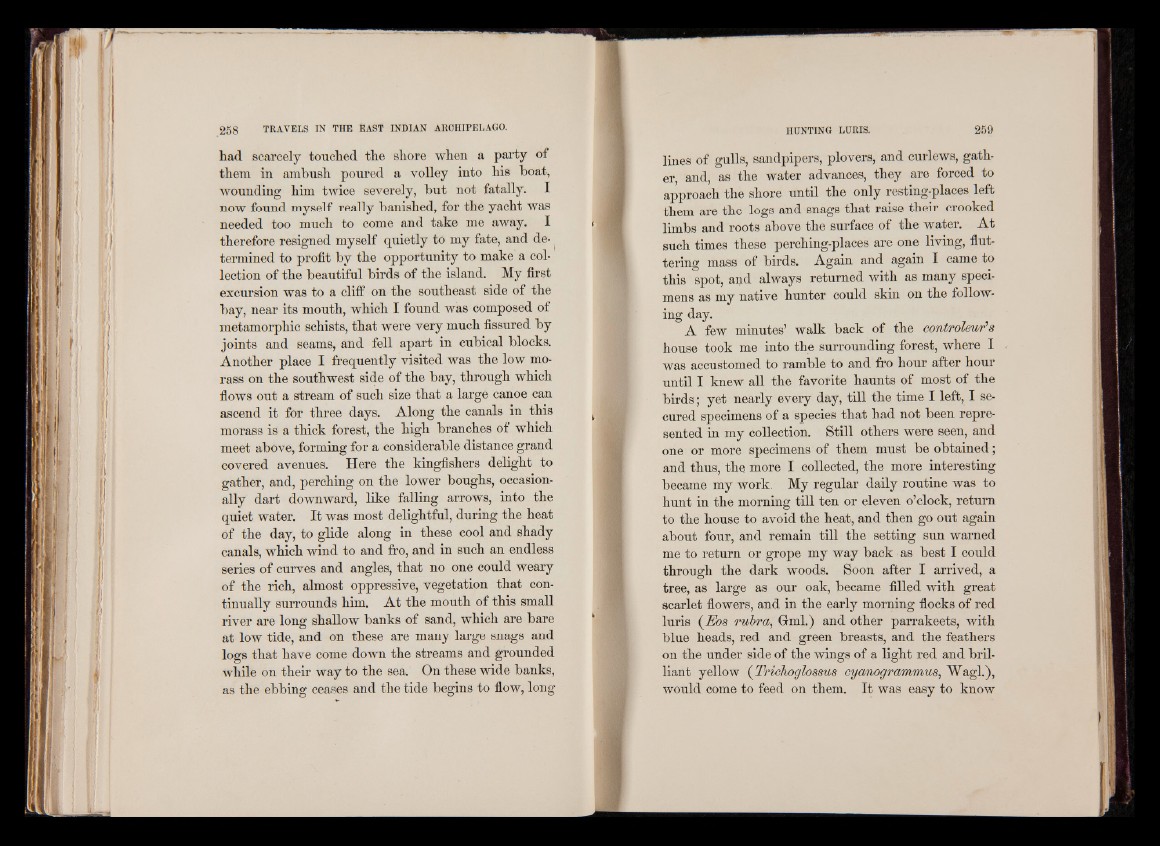
had scarcely touched the shore when a party of
them in ambush poured a volley into his boat,
wounding him twice severely, but not fatally. I
now found myself really banished, for the yacht was
needed too much to come and take me away. I
therefore resigned myself quietly to my fate, and de-
termined to profit by the opportunity to make a collection
of the beautiful birds of the island. My first
excursion was to a cliff on the southeast side of the
bay, near its mouth, which I found was composed of
metamorphic schists, that were very much fissured by
joints and seams, and fell apart in cubical blocks.
Another place I frequently visited was the low morass
on the southwest side of the bay, through which
flows out a stream of such size that a large canoe can
ascend it for three days. Along the canals in this
morass is a thick forest, the high branches of which
meet above, forming for a considerable distance grand
covered avenues. Here the kingfishers delight to
gather, and, perching on the lower boughs, occasionally
dart downward, like falling arrows, into the
quiet water. It was most delightful, during the heat
of the day, to glide along in these cool and shady
canals, which wind to and fro, and in such an endless
series of curves and angles, that no one could weary
of the rich, almost oppressive, vegetation that continually
surrounds him. At the mouth of this small
river are long shallow banks of sand, which are bare
at low tide, and on these are many large snags and
logs that have come down the streams and grounded
while on their way to the sea. On these wide banks,
as the ebbing ceases and the tide begins to flow, long
lines of gulls, sandpipers, plovers, and curlews, gather,
and, as the water advances, they are forced to
approach the shore until the only resting-places left
them are the logs and snags that raise their crooked
limbs and roots above the surface of the water. At
such times these perching-places are one living, fluttering
mass of birds. Again and again I came to
this spot, and always returned with as many specimens
as my native hunter could skin on the following
day.
A few minutes’ walk back of the conProleur’s
house took me into the surrounding forest, where I
was accustomed to ramble to and fro hour after hour
until I knew all the favorite haunts of most of the
birds; yet nearly every day, till the time I left, I secured
specimens of a species that had not been represented
in my collection. Still others were seen, and
one or more specimens of them must be obtained;
and thus, the more I collected, the more interesting
became my work. My regular daily routine was to
hunt in the morning till ten or eleven o’clock, return
to the house to avoid the heat, and then go out again
about four, and remain till the setting sun warned
me to return or grope my way back as best I could
through the dark woods. Soon after I arrived, a
tree, as large as our oak, became filled with great
scarlet flowers, and in the early morning flocks of red
luris (Eos rubra, Gml.) and other parrakeets, with
blue heads, red and green breasts, and the feathers
on the under side of the wings of a light red and brilliant
yellow ( Trichogbssus cyanogrammus, Wagl.),
would come to feed on them. It was easy to know